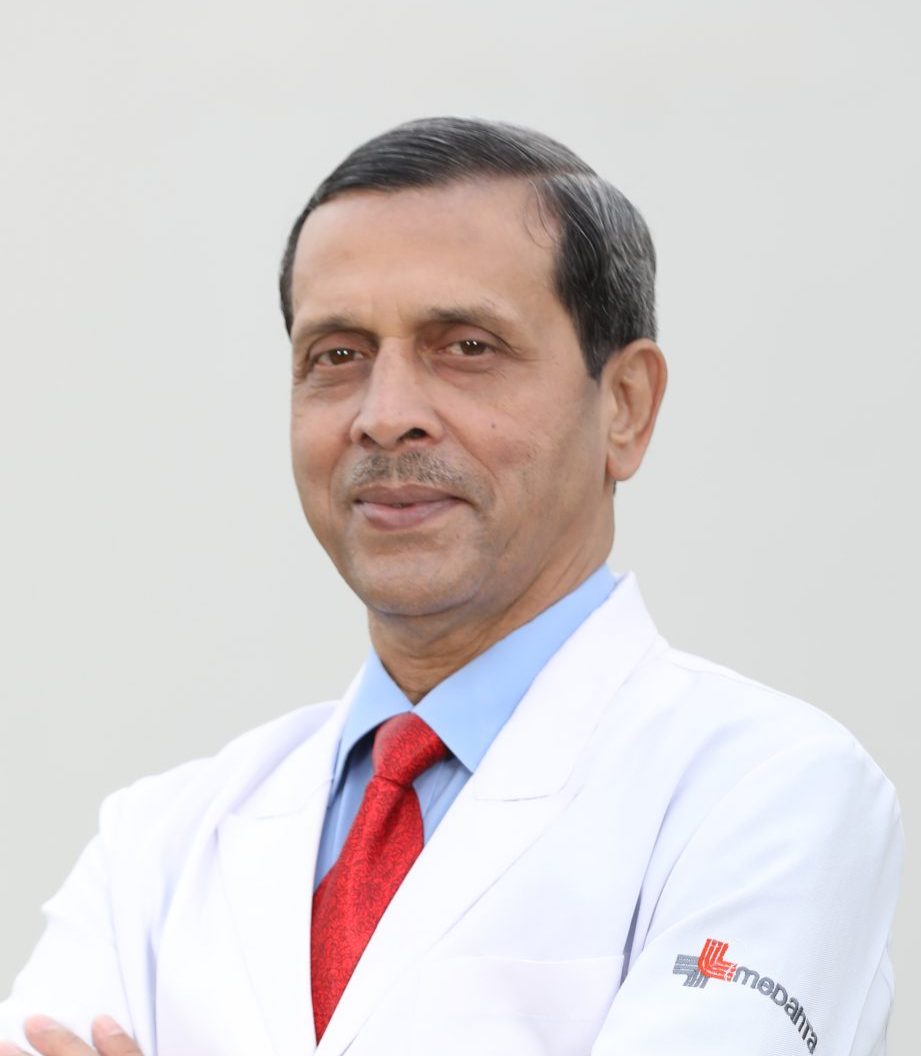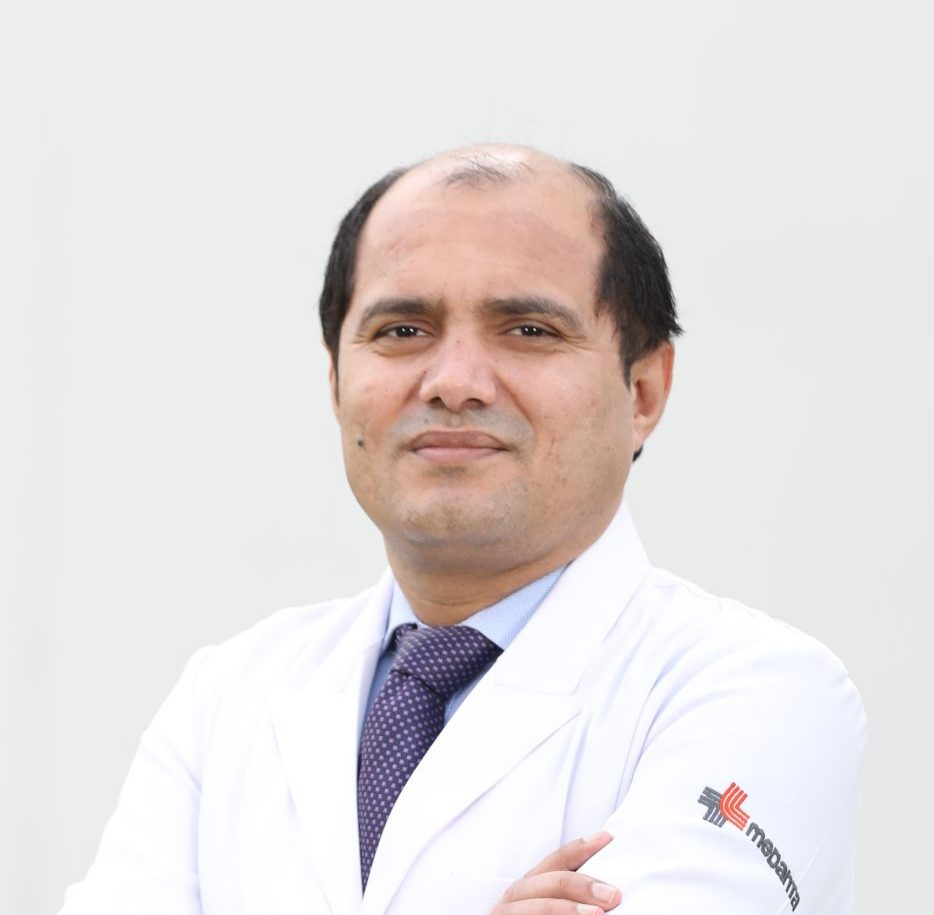Institute of Chest Surgery- Chest Onco Surgery and Lung Transplantation
What we treat
Institute of Chest Surgery, Chest Onco Surgery & Lung Transplantation provides comprehensive treatment options for all ailments and diseases related to Lungs, Trachea & Bronchus, Pleura, Mediastinum, Esophagus, Chest wall & Diaphragm.
Lung cancer is a type of cancer that begins in the lungs. Lungs are two spongy organs in the chest that take in oxygen when we inhale and release carbon dioxide when we exhale. Lung cancer is the leading cause of cancer deaths worldwide.
People who smoke have the greatest risk of lung cancer, though lung cancer can also occur in people who have never smoked. The risk of lung cancer increases with the length of time and number of cigarettes smoked. The Chest Surgery Team at Medanta has largest experience of offering surgical treatment with Minimally Invasive Techniques like VATS and Robotic Surgery.
Lung Nodule is a small round or oval-shaped growth in the lung. It may also be called a “spot in the lung”. Lung nodules are smaller than three centimeters (around 1.2 inches) in diameter.
There are two main types of pulmonary nodules: malignant (cancerous) and benign (noncancerous). Benign pulmonary nodules can have a wide variety of causes. Many are the result of inflammation in the lung as a result of an infection or disease producing inflammation in the body. The nodule may represent an active process or be the result of scar tissue formation related to prior inflammation. Benign developmental lesions may also appear as nodules.
Myasthenia gravis (MG) is a relatively rare autoimmune disease that leads to fluctuating weakness of voluntary muscle groups throughout the body. The thymus gland plays a major role in the causation and onset of MG. Approximately 10 to 15 percent of MG patients develop a tumor of the thymus gland, known as thymoma. However, thymoma can develop without MG also. So, a patient may have MG, or Thymoma, or both.
Da Vinci Robotic Surgery is currently the best method to achieve complete and radical removal of the thymus gland for MG as well as Thymoma. Prof.(Dr.) Arvind Kumar and Team started this program in India in the year 2008 and have since performed the largest number of such robotic operations on patients from across India and Asia pacific region. Even thymomas as large as 10 cms size have been succesfully resected robotically by their team
Esophageal (food-pipe) cancer usually begins in the cells that line the inside of the esophagus. Esophageal cancer can occur anywhere along the esophagus. More men than women get esophageal cancer.
Esophageal cancer is the sixth most common cause of cancer deaths worldwide. Esophageal/oesophageal cancer usually presents with difficulty in swallowing, initially to solids and then liquids also.
Chest wall refers to the rigid framework which houses and protects various organs in the chest. It is composed of muscles and bones and other soft tissues. Any of these tissues can develop a tumour which is basically an abnormal growth of cells. These tumours can be benign (non-cancerous) or Malignant (cancerous). Chest Wall tumors usually cause no symptom and present as a lump growing in the chest wall. Tumors of the chest wall include those that grow on the ribs and sternum.
Chest houses most vital structures of the body and in unfortunately the site of trauma in road accidents as well as stab and gun-shot injures. While some may be fatal on the spot many patients reach hospital in a critical state and need immediate treatment for injuries. These injuries many range from one to many rib fractures, fracture of sternum (breast bone), injury to lungs leading to hemothorax (collection of blood around the lungs ) or pneumothorax (air around the lungs), injury to trachea (wind-pipe), esophagus (food pipe), diaphragm (layer between the chest and the stomach)
Bronchiectasis is a long-term condition where the airways of the lungs known as bronchi become abnormally widened, leading to a build-up of excess mucus that can make the lungs more vulnerable to infection
A cyst is a cavity filled with fluid. Lungs can have cysts like hydatid cyst, bronchogenic cyst, dermoid cyst or many other type of cysts. If left untreated, these cysts increase in size and can cause cough, blood in sputum, chest pain or fever. They can also put pressure on neighbouring structures causing various symptoms or can rupture with life threatening serious complications.
Why choose Medanta?
Our holistic approach to treat you
Chest disease patients are increasing in numbers rapidly in our country. Despite lot of efforts, the awareness and treatment facilities are not unfiform across the country. An organised chest surgical service actually doesnot exist at very many centres. The Institute of Chest Surgery, Chest Onco Surgery & Lung Transplantation @ medanta was created to fill this void and provide top end surgical care to cancer as well as non cancer patients and give them benefits of open surgery, VATS or Robotic Surgery as the need may be. In addition, we also run programs to train surgeons as well as nurses in the art of chest Surgery.
Our Expert's Videos
Meet Our Experts
The Team has received rigorous training at the prestigious Toronto General Hospital (World’s largest volume lung transplant center). Team has an unwavering commitment to deliver quality care.
Understanding Lung Transplant Procedure
A recipient is a person with end stage lung disease for whom no medical or surgical therapy is available and has a limited chance of survival if left untreated.
A recipient is a person with end stage lung diseases for which no medical or surgical therapy is available and has a limited chance of survival if left untreated.
Carried out by an accredited lung transplant centre.
A person with end stage lung disease is identified by his treating physician and referred to a lung transplant centre.
The above patient is evaluated by a transplant pulmonologist at the lung transplant centre and if he meets the selection criteria for lung transplant, he is admitted for a series of tests and examinations to evaluate his physical and mental fitness for the same.
After complete workup, patients who are considered eligible and are fit for lung transplant and where the family consents for the same, the patient is notified on the lung transplant recipient waiting list of the state or region or nation of transplant organization (SOTTO / ROTTO/NOTTO). These are government agencies which control and coordinate the distribution of organs as per law.
After being notified on the waiting list the recipient is requested to move to the same city as the lung transplant centre. The medical treatment, nutritional support and physiotherapy is continued under the supervision of the transplant team.
Whenever, the family of a brain dead or a cardiac death person consents to organ donation, the details of the donor are provided to the state or regional or national organ transplant organization which matches it with the waiting list and allocates the organ using blood group, size matching and geographical location as the criteria.
Once the team at the recipient centre receives a lung offer from the transplant organization, they connect directly with the team at the donor hospital and look critically at the blood group and size matching and also look at the oxygenation (i.e. blood gases) and CT Scan of the lungs to check the fitness of the lungs on offer.
After accepting the lungs on offer (as per steps mentioned above), the recipient hospital surgeons team removes the lungs from the donor (called explantation) as per a laid down procedure and packs them into an ice box for transport back to the recipient hospital again as per a laid down procedure.
While the recipient team is moving towards the donor hospital, another team at the recipient hospital admits the recipient and prepares him for the transplant process. As soon as the lungs on the offer are accepted (and also depending on the travel time from the donor hospital to the recipient hospital) the recipient is wheeled into the operation room and anesthetized and operation started .
As soon as the recipient hospital team arrives in the operation room with the donor lungs, the recipient’s native lungs are removed from his body and the donor lungs are implanted in a sequential manner.
As per the current evidence, most of the recipients are put on artificial support (ECMO) during the transplantation process. This has been shown to help in the quick recovery of the transplanted lungs.
As the donor lungs are considered a “foreign body” by the immune system of the recipient, it mounts a massive immune response which destroys the donor lungs very fast. In order to prevent this from happening, the recipient is started on Immunosuppression i.e. medicines to reduce the immune response of the recipient. These medicines are started before the operation and are continued post operatively, forever.
Rejection and infection are the two major issues in the long term follow-up of these patients for which the patient needs to visit the hospital on a regular basis, undergo various tests at regular intervals and take immunosuppression and infection prevention medicines on a regular basis, life long.
Medanta: Voted as the best private hospital in India for three consecutive years in 2020 to 2022 (Newsweek)

Medanta: Voted as the best private hospital in India for three consecutive years in 2020 to 2022 (Newsweek)
- Equipped with state of the art advanced technology.
- 800+ doctors led by highly experienced department heads.
- World-class infrastructure spanning around 2.1 million sq. ft. campus.
- 1,300+ beds & facilities for over 22+ super-specialties, all under one roof.













